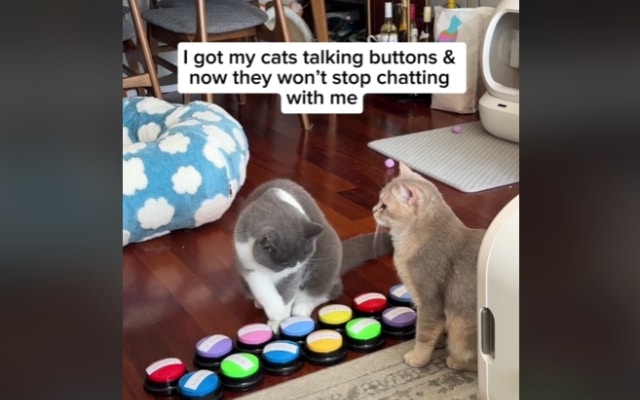Many pet owners believe their animals understand them, but for Prince Louie and Todd, their cats are actually responding using special speech buttons! These two feline friends have mastered expressing their needs by pressing a device that speaks words when touched with their paws. Their owner shared an adorable video showing the cats “conversing” with each other. Some of their requests were irresistibly charming!
Even though Prince Louie and Todd can only use simple words and short phrases with their talking buttons, they communicate their desires clearly. Impressively, they remember to include “please” when making a request!
Each cat has distinct preferences. Todd often asks his owner for treats, while Prince Louie usually seeks some cuddles.

“Treat, please,” Todd said in the video, pressing individual buttons to form his request. “Now. Tuna.”
On the other hand, Prince Louie used the device to say, “Love you. Pets, please, Dad.”
As expected, their owner happily gave them some chin scratches after the cats made their polite requests using the buttons!
Do cats really understand what they’re saying with talking buttons?

While videos like these are certainly entertaining, they also play an important role in animal research. According to WHYY, clips of cats and dogs using talking buttons to communicate have revived interest in whether our pets can learn and understand human language.
Throughout history, many researchers have attempted to teach animals to “talk” using sign language and other methods of communication. Sadly, most of these efforts didn’t succeed. For example, orangutans could learn to mimic signs, but it became clear they didn’t understand the meanings behind their gestures. Some experiments even left the animals confused and distressed.

This is where Leo Trottier, the founder of FluentPet, comes into the picture. By providing talking buttons for cats and dogs, pet owners on social media generated a significant amount of new research. Trottier then collaborated with cognitive scientist Federico Rossano to develop these findings into a formal study, which was recently published in PLOS.
Psychology Today reports that this innovative study suggests that dogs, at least, do grasp the meanings of human words to some extent.
“The results are not surprising to anybody who has a dog or knows animal cognition,” says Rossano. “But this study was a necessary step to address the criticism that many people have, which is that soundboard-using dogs may simply be following behavioral cues from their owners without understanding what they are asking for.”
Based on this research, it’s quite possible that Prince Louie and Todd truly understand what they’re saying when they request treats and head scratches using their talking buttons. This also implies that when they say “now,” they genuinely mean it!
Please ‘SHARE’ to pass on this story to a friend or family member
Watch on TikTok

